AG TIRE TALK KEY TAKEAWAYS
MAXAM: “As a General Performance Rule, MFWD & 4WD Tractors (+100 HP) are 65% of the Market – What sells today as a new OE fitment replaces @ 5 years”
MICHELIN: “How do we care for tires, so they have a better chance to reach their rubber lifespan? Keep a close eye on air pressures, take weight off tires during periods of prolonged storage….”
ASCENSO: “The normal Rear Ag Tire Position today, on Tractors, is probably the easiest to get good performance out of- much different than applications for Sprayers, Combines…”
YOKOHAMA TWS: “Studies have shown that a tire’s lifespan will be reduced by 25% if you drive frequently on the road with under inflated tires.”
YOKOHAMA OFF-HIGHWAY TIRES AMERICA: “The most important factor in extending the life of most farm tires is minimizing the buildup of heat.”
PRECISION INFLATION: “Simply raising tire pressures for the road and decreasing for the field with CTIS (Central Tire Inflation Systems), you will EASILY see 20% longer tire life.”
BKT: “On MFWD Tractors, the Fronts are Drive Tires, wearing out about 2-1 compared to the rears, especially where traveling on the road is required- they turn 1.3 to 1.5 times faster than the rears.”
Maxam Tire International
Greg W. Gilland: Vice President Global Agriculture
In the agricultural industry, it is how the equipment is utilized or the inherent operational requirements that will affect tire life. As agricultural tires are considered “off-road” and not US Department of Transportation (DOT) regulated, there are no firm rules to determine when an ag tire needs to be replaced. However, how the tires are utilized will determine the usable service life of a tire. In all instances, the type of machinery, soil conditions, application (intensity of use), and air pressure maintenance will have a direct impact on its ability to deliver an improved service life. Listed in the below table are some general performance rules of the Ag industry, detailing expected tire life span or replacement cycles by platform or machine category:

General Performance Rules in the Ag Market for Large Ag Drive Tire Replacement:
- MFWD & 4WD Tractors (+100 HP) are 65% of the Market – What sells today as a new OE fitment replaces @ 5 years.
- Combine / Harvesters are 10% of the Market – What sells today as a new OE fitment replaces @ 10 years.
- Application Equipment is 15% of the Market – Tires are replaced every 1-2 years depending on the amount of roading.
All the above service life expectations are predicated on how the tires are mounted, used, and maintained. Listed below are some general reasons for tire removal or replacement in all cases, MAXAM recommends utilizing ag tires for the longest possible time regardless of the type of tire so long as the tire can be safely employed to meet operational requirements and deliver the value of the tires:
General Tire Replacement Guidelines for Farmers & Growers:

The leading cause of tire replacement is severe tire wear or tire wear-out, resulting in a loss of traction noted by increased machinery slip rates. How a tire “wears” is directly linked to the actual weight being carried by each axle as dictated by the working speed of the machinery in service. If the tire’s cold inflation pressure is set to the right air pressure based on the axle load for a given work speed, all radial Ag tires (standard, IF or VF) are designed to deflect or bulge on the sidewall transmitting the optimal tire tread footprint to achieve a reasonable service life.
In all cases, tire manufacturers must abide by industry standards that reference or set the recommended air pressure based on speed and weight bearing capability. If a farmer or grower chooses to lower the tire air pressure to increase the size of the tire footprint with the goal to achieve lower soil compaction or to gain more traction, then the axle load being carried must be measured/weighed so that the correct air pressure is identified to ensure optimal tire wear. Another advancement in the Ag industry to enhance both tire wear and service life is the addition of steel belts under the tread, improving both the stability or traction of the tread face while increasing the resistance to damage caused by spin cuts, stubble damage, or rock impacts. The final consideration in getting improved performance or greater service life from your radial Ag tires is to employ R-1W (W for Wet traction) type tires that are manufactured with +20% deeper tread than standard R-1 tires providing both higher resistance to damage and longer lasting tread rubber.
The advent of IF or VF Technology in radial tires has allowed some of the above rules to be re-written as farmers or growers can either significantly lower air pressure without compromising the carrying capacity of the tire or increasing the weight carried with the same tire footprint (same gross flat plate). Both technologies allow farmers to achieve better yields or greater productivity in the field with heavier or faster machinery. Also, another tool that is very popular in the European market and growing in the North American market is the use of “On-Board” Tire Inflation or Central Inflation Systems that deliver the capability to inflate or deflate the tires as needed based on the required work speed or axle load. It works by receiving data from either an RFID or sensor tag, located by wheel position on the machinery, and allowing the operator to adjust the tire inflation pressure in real time without having to stop the machinery ensuring enhanced tire service life.
In all instances, whether working in the field at slow speeds or transporting the machinery (roading) from field to field at higher speeds, managing proper tire inflation pressures for every work application will ensure that the tires can deliver the optimal performance and long service life by:
- Reducing ground compaction as tire load is based on the actual load per axle or per tire as needed.
- Greater crop yields as the compaction impact on the soil is minimized by the improved tire footprint.
- Improved fuel efficiency as the tire is optimized for each work application or towed implement.
- Greater productivity in the field as the tire’s footprint and traction provide increased efficiency.
Michelin Ag
David Graden: Operational Market Manager – Agriculture
This question has afflicted farmers and RV goers, alike, for a very long time. As a tire nerd, what I find interesting is the definition of “Tire Life Span” will be different for each tire manufacturer due to differences in quality, intended usage, mileage/hours use, etc. I like to define tire life as the life of the rubber that tire is built from, which I will explain a little more later.
At Michelin, what we’ve learned through decades of research and development is, tires cannot be developed for the best of all worlds. Some tires need to be cut and chip resistant, which means the rubber compounding must be harder (in short). If you want a tire that is good on hard surfaces and snow, the rubber compounds need to be more supple and have more flexibility. Today, it’s impossible to individually maximize each of these in one tire, so we (Michelin) work very hard to get the most out of each and combine them for specific application tires like “High Traction” and “Hard Surface” specifications.
My point is rubber compounds ultimately determine how a tire will age. Harder rubber compounds will age differently compared to softer rubber compounds. Then, of course, you also have to consider actual usage and the atmosphere the tires will live in.
Twenty years ago, tires aged very differently than today. Before about 2006, tires would harden over time. In fact, many farmers and tire dealers would purchase farm tires and let them sit in the sun for months or even years to let them continue to “cure.” The idea was the tire rubber would continue to harden and would be a better product for the end user by the time they were sold. Whereas there may be a little truth to this concept, the overall idea really didn’t affect the performance of the rubber.
Back then, this effect was caused by aromatic oils, which were used in the making of tires. Contrary to the name, aromatic oils did not give tires their lovely smell. In fact, they were used in the processing of rubber compounds and added that “sticky” effect to rubber on hard surfaces in wet conditions, in addition to improved wear and durability. Unfortunately, around 2005, the ETRMA (European Tyre & Rubber Manufacturers’ Association) determined these oils contained carcinogenic properties and worked to ban them from all tires that are manufactured in and imported to EU countries by around 2010. Well, this posed a big problem for all major tire manufacturers because now they had to find an alternative to these oils. As of today, testing continues with oils such as safflower oil, soybean oil, sunflower oil, etc.
Before the removal of aromatic oils, we wouldn’t see this cracking for up to 20 years, depending on environmental conditions, of course. Today, due to Michelin’s design and very deep standard depth of our lugs, we typically see about 14 years before the rubber begins to show cracking in the sidewall, aka ozone cracking.
To get to the point, while working around tires of all brands, in the past, I have personally witnessed an average of about a 14-year rubber life for higher end tires and as little as 8-10 years for very low-cost tires. For Michelin, though, the performance remains through the end of the life of that rubber due to the design and depth of our tread bars. At the end of rubber life, the Michelin tire will often continue to have significant lug depth for tractive capacity and perform very efficiently. In fact, from a tread wear perspective, all Michelin tires have some resistance to stubble, so many tires actually live to that 14-year rubber lifespan instead of being ruined by stubble damage. After that, I tend to recommend adding Michelin tubes to the tire to further extend the life and even avoid inconvenient downtime during the season.
The next question is how do we care for these tires, so they have a better chance to reach this rubber lifespan? Well, rubber is negatively affected by heat, excessive or continued work under torque, storage practices, etc. If you want to take steps to prolong the life of your tires and get all the life the rubber compounds have to offer, I recommend the following:
- Keep a close eye on air pressures. Try not to let the air pressure fall too low over the winter months.
- If possible, take the weight off your tires by lifting the machine slightly during prolonged periods of storage. This will help to prevent stress at the top of the tire casing and cause “flat spotting.”
- When the machine is not in use, store in a cool dry place. Heat is the enemy of rubber and will cause it to fatigue much faster.
- Make sure your tires remain clean and free from any petroleum based products. I have seen many tires where oil has puddled under or on top of tires for a long period of time. This causes rubber to become brittle and crack.
- During operational months, pay close attention to your tire pressures. Make sure to have them set at the proper recommended pressures for the load, speed and application. This will prevent unnecessary damages and wear on the lugs and casing of a tire. You can contact your local authorized Michelin Ag dealer for this information or your local Michelin sales representative, as these recommendations typically need to be calculated based upon your machine weight, balance between front and rear and application.
To conclude, I firmly believe you get what you pay for when it comes to tires. Much like your pickup truck or family vehicle, if you take care of them, they will last for a very long time.
Ascenso Tires North America
Nick Phillippi: Product Manager / Technical Support North America
Wow, another tough question with so many questions needing answered to give a good answer. What is the tractor used for? Roading, heavy loads, heavy torque? How many hours is it used per year? 100, 300, 600? What conditions are the tires subject to? Manure, always in sun, gas or oils, extreme heat or cold?
Rear ag tires, using the 80% rule, should last 8 years with no issues in normal conditions. Correct PSI for weight and speed, normal torque, ~20% roading, stored under cover when not used for longer periods. I base that on the fact that most warranties today are 7-10 years and someone knows the statistics to set those time lines. I have seen tires last 20 years and some that didn’t make it 4 and I’m sure all your listeners have as well. Some of this spread is due to the quality of the product no doubt and some is due to the care of the product.
My opinion is that the normal Rear Ag Tire Position today, the subject of this question, on tractors is probably the easiest to get good performance out of. Much different than applications for sprayers, MFWD, combines, carts or even some of the largest implements. They are sized to be able to meet the weight and speed needs without being stretched to their limit in most set ups from the factory and they don’t have much stubble risk. We do still need on board air to maximize the tire performance, especially with VF products.
With more science involved, the compounding has become very technical and very important. The use of chemicals and other ingredients, done correctly, has helped in the areas of ozone cracking, stubble damage, wear and flexibility for all types of applications. The proper use of these ingredients adds cost to a tire and can’t really be noticed or appreciated by observation.
Construction is also important, from a length of life perspective, the quality inner liner on tubeless tires is a key measure of quality. If a tire sits and does not lose more air than is normal with weather changes its indicative of a quality inner liner and most likely a quality tire. As for air pressure, I believe when storing a tire for a long period, it needs to be set at just over the air pressure for the weight being held. I am certainly old school with this, but I also think if weight can not be taken off a tire, then I would try to move the tractor (vehicle) slightly every 2-3 months when in storage for the winter. Some will say its’ not needed but I say it can’t hurt.
Of course good practices will add to the life of a tire. Proper inflation is key, even when the vehicle is sitting. Washing off the tires from manure, oils or other foreign substances is a good practice. Storing tires out of direct sunlight when possible will also certainly pay off in tire life over time.
Yokohama Off-Highway Tires America, Inc.
James Crouch: National Segment Manager—Agriculture and Foresty
There is a huge range of variables influencing the lifespan of a farm tire, from the construction and quality of the tire to how it’s used, local soils and conditions, and even how a particular operator drives and turns. But farmers can pull a few levers that can help them get the most life out of their tires.
The first way to maximize tire life is to buy high-quality tires. Radials tend to last longer than bias-ply tires. Pay attention to the materials used in their construction—for instance, all-steel construction is best for durability and heat dissipation, while casings made out of polyester plies will hold their shape and wear better than nylon. Stubble guard compounds minimize punctures and stubble damage. And special design features ranging from reinforced sidewalls to bead guards can boost tire life, too.
Tread pattern has a huge influence on tire life, and not always the way people think. For instance, deeper lugs are not always better when it comes to choosing among R-1, R-1W and R-2 tires because tire life is not just a matter of how much rubber you have. If you’re operating primarily in mud, the deeper lugs of the R-1W or R-2 can be a great investment. But if you’re operating primarily in dry or hard soils or doing a lot of roading, deep lugs will scour off more quickly or flex and crack, actually reducing your tire’s life. In those cases, you’d be better off with a shallower R-1 tread.
Or you could get away from the standard curved R-1 lug altogether. For tractors doing a lot of roading, a denser, hybrid block tread like the Alliance 550 or Alliance 363 can reduce abrasion wear and dramatically increase tire life—and you’ll have a better ride, too, which can actually increase the life of your tractor.
Speaking of rubber, storing tires out of the sun, rain and winter weather can improve tire life—UV, water and extreme temperatures take their toll on rubber compounds. So can oil and other solvents. Also, keep tires away from electric motors, which produce ozone that damages tire compounds and accelerates tire aging.
The most important factor in extending the life of most farm tires is minimizing the buildup of heat. As one of our engineers used to say, “A tire is born in heat, and it dies in heat.” Don’t overload your tires. Don’t operate at speeds higher than they are built to handle. And the single best thing you can do for your tires is to operate them at the correct inflation pressure, which minimizes the chance of overheating.
Last—but absolutely not least—is operating your tires at the proper inflation pressure. Maintaining the proper inflation pressure optimizes the tire’s footprint. The better the footprint, the lower the slip, the lower the heat, and the longer the tire life. It’s that simple.
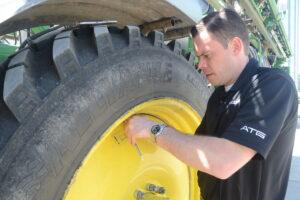
That’s why, if you can afford it, a central tire inflation system (CTIS) can be a great investment, especially if you have also invested in IF or VF tires, which deliver huge benefits from very low inflation pressure in the field. And if you’re inflating your tires manually, just a few minutes and a $5 pressure gauge can add months or years to the life of your farm tires.
Yokohama TWS
Chris Neidert: AG Marketing, Training & Development Manager for Trelleborg & Mitas Tires – North America
Unfortunately, trying to predict the average life span of an AG tire is like trying to pick the best automobile. There are a lot of variables, and it depends on the application, environment, and others.
We are going to approach this question as the above statement reads – what steps can a producer take to pro-long tire life.
ADJUST AIR PRESSURE MORE OFTEN
There is no average pressure at which you can do everything. Type of ground, speed and the type of load all contribute to making an air pressure decision.
Overinflation
Many farmers tend to increase the inflation pressure in their tires as a precaution, to avoid having to check tire pressure based on load in order to save time.
Overinflation can lead to premature wear in certain conditions. Practically speaking, an overinflated tire is more rigid, which is more suitable for the road. However, in the field, it will have a reduced contact patch with the ground. This will reduce its traction capability, increase slippage, and increase ground pressure leading to soil compaction. In the long term, this will considerably reduce the production capacity. There is a major risk of rapid wear with high inflation pressure. The high pressure within the tire corresponds to the pressure exerted on the ground, the higher the pressure, the more the tire sinks into the loose soil in the field, especially in wet conditions. Deep tilling will lead to excessive slippage and result in rapid wear to the tread. On the road, an overinflated tire will bulge in the middle, reducing contact with the ground in the center of the tread, which is likely to lead to faster, more marked wear on the central part of the tire. Our example to the right is showing overinflated wear. Notice how the tread is worn in the center.
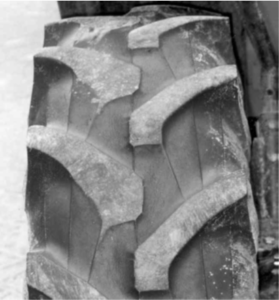
Under Inflation
There are different drawbacks to driving with under inflated tires (we do not recommend this under any circumstances), leading to excessive wear.
What types of wear are linked to an underinflated tire:
When driving, an under inflated tire tends to flatten out into a characteristic form. Excessive casing deflection occurs at the level of the sidewalls and the tire cannot regain its original shape. This leads to a rise in internal temperature, the structure of the tire deteriorates progressively and irreversibly, which may lead to a sudden puncture or break in the casing. Although the wear does not appear immediately, it may become visible later, even after the inflation pressure has been adjusted.
Studies have shown that a tire’s lifespan will be reduced by 25% if you drive frequently on the road with under inflated tires, especially if this type of surface is highly abrasive. The tire effectively overheats, making the rubber more supple and therefore more vulnerable to wear. Ideally, you should adjust inflation pressure based on the load, the application, and the type of ground.
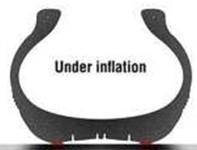
CORRECTLY BALLAST THE TRACTOR
Besides air pressure, tractor ballasting is another neglected area of tractor operation. You spend a lot of money to get that power from the tractor, and you need to maximize that transfer of power to the ground. Our picture depicts what you are ultimately trying to accomplish. Get the most out of your tractor horsepower. Here are some guidelines to help you calculate the optimum ballast or total tractor weight.
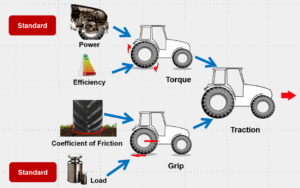
MFWD Target is approx. 120 lbs./Tractor hp.
If you have a MFWD (Mechanical Front Wheel Drive) tractor, take the horsepower and multiply it by 120. This is your target total tractor weight. This would be for heavy pulling.
4WD Target is approx. 105 lbs./Tractor hp.
If you have a 4WD (4 Wheel Drive) tractor, take the horsepower and multiply it by 105. This is your target total tractor weight. This would be for heavy pulling.
Next you want to make sure the total tractor weight is correctly distributed between the front and rear axles.
Here is a chart suggesting axle weight splits to properly spread out that total tractor weight for optimum tractor performance and tire performance.

The surest way to verify your weight and axle splits is to have your tractor weighed on scales.
For additional information on making exact calculations, please contact me.
CHOOSE THE CORRECT TIRE
Buy the Right Tractor Tire
If the air pressure that you need to be using is at the upper end of the tire’s load table, consider switching to IF or VF tires. IF (Improved Flexion) tires let you run up to 20% less air and still carry the load of a standard tire. VF (Very High Flexion) tires let you run up to 40% less air and still carry the load of a standard tire. This lower pressure will provide benefits. The tire will run cooler and provide longer tire life. A larger footprint will put more rubber on the ground in the field and extend tire life, reduce compaction, and provide better traction.
Buy the Right Combine Tire
Just as the above, if your combine tire air pressure is at the upper end of the tire’s load table, consider switching to CFO or CHO tires. IF or VF CFO (Cyclical Field Operation) tires can withstand a temporary overload situation of between 33% and 50% from the nominal load capacity. CHO (Cyclical Harvesting Operations) tires can provide up to an 80% load bonus from the nominal load capacity. These two bonuses will go a long way to extending your combine tire’s life during its cyclical operations.
Choose the Right Tire Size
It is crucial, when buying tires, to choose the right tire size for the specific piece of equipment. To avoid premature wear and guarantee your tire’s resistance, make sure that your tire size and load index correspond to your maximum loads including implements and trailers. In any case, do not to overload your tires and follow the tire’s load table for recommended air pressure, always consulting with your Certified AG Tire Dealer.
Choose Tire According to Application
The tire’s application is one of the several factors which could lead to the premature wear of your agricultural tires. If you have chosen low-pressure tires designed for work in the fields and you use them in a quarry or forest area, this will considerably accelerate the rate of wear in addition to the risk of even bigger problems. If your application is mostly mowing, in the yard or operating on improved roads, a less aggressive tread pattern will provide longer tire life than an R-1 or R-1W tread pattern.
ROTATE YOUR TIRES
When your right tires wear faster than your left tires, or the other way around, you can swap them over, on the condition that this is not caused by a mechanical problem (misalignment or mounting error). Swapping your tires around may be an interesting way to optimize wear over a longer period of time. This is particularly useful for the front tires of a sprayer or a heavily roaded tractor.
CHECK MECHANICAL CONDITION
One of the most frequent causes of ag tire wear is geometry problems. This type of problem is linked to the different types of strain imposed on your tires during use.
The angle settings to be checked are:
- Between the Four Tires & Road
- Between the Tires & Tractor
- Incorrect Adjustment between the Tires themselves.
Check the parallelism:
The angle between the direction of travel and the axis of the wheel is called parallelism. You want your tires to be perfectly parallel to the direction of travel. If this is not the setup, you could wear the interior (toe-out) or the exterior (toe-in) of the tire. Some toe out angle is recommended, in order to offset the mechanical power linked to the traction force encountered by the front axle when in four-wheel drive.
MAKE SURE LEAD/LAG RATIO IS CORRECT
The lead ratio is the number of rotations the smaller front tires make in relation to the larger rear tires on MFWD tractors. It enables the synchronization of the front and rear axles of the tractor. All MFWD tractors will have some positive lead. This means the front tires turn slightly faster than the rear. It must be correct to avoid your tires wearing rapidly, given that an incorrect lead ratio results in premature wear to the two front tires compared to the rear tires or the other way around.
The wrong lead ratio also results in wear to the mechanical parts. To keep your tires longer, make sure your ratio is within tolerance. Normal lead ratio is 1-4%. If the lead ratio is above 4 or 5%, the rear axle slows down the front axle, meaning that the front tires are actually pulling the tractor, thus causing wear to the front tires. If the lead ratio is 0% or below (lag), the rear axle pushes the front axle too much, causing excess slippage at the rear and making the front axle less efficient. If you keep driving in these conditions, in addition to tire wear, you are likely to damage your tractor’s gear box. You can contact me for help on this.

Precision Inflation, LLC
Ken Brodbeck: VP Technology
Let’s start with a Rear Drive R-1 Bias Tire as a base compared to a Radial R-1 40 years ago.
Bias tires had an expected life of 2500 hours and radials lasted 30% longer or 3250 hours.
Today, the old standard R-1 Tread Depth has moved to R-1W or an additional 25% deeper tread depth. If wear is linear, then our expected life goes up to 4060 hours.
This sounds about right in my 40+ years of experience. So, how does one maximize tire life?
Let me count the ways:
1. Find a tire dealer you trust. He will know your needs. If there are any warranty issues, he is your partner.
2. You get what you pay for. Again, your dealer and your past experience will guide you which tire to purchase for your new or used machines.
3. Weigh your machine! Dealers and/or tire representatives should have portable scales.
4. With the weight per axle, look up the tire’s load/inflation chart and set the pressure 2 to 3 psi above the minimum. WHY, because gauges may be off and when temperatures drop, so does the tire pressure. 1 psi for every 10 Degrees F.
5. Ideally, check your pressures once per week. An underinflation or overload will not only fail the tire, but also create VERY fast wear on the road due to tread scuffing. I have seen tires worn out in under 1500 hours.
6. Remember MFWD tractor’s front tires usually make 30% more revolutions than the rears. A good tread pattern up front is a must. Firestone has made a specific front pattern with a curved pattern that is the standard for the industry.
7. Be sure MFWD Front and Rear tires are matched correctly for the tractor’s gearing. Also known as LEAD/LAG. Again, I have seen tires wear out in less than 1000 hours due to the 2 axles fighting each other with incorrect front/rear combinations.
8. Abuse from high slippage can quickly destroy tires. SEE points #3 and #4.
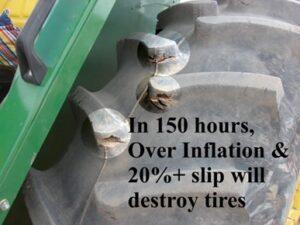
9. Use a stubble device to protect tires in harvest and no till conditions!

10. MOST IMPORTANTLY, IF and VF tires have a great, LONG footprint in the field. The drawback is that LONG FOOTPRINT on the road scuffs off the lugs faster than standard tire pressures. WHAT CAN YOU DO to protect your VF tire investment?
Raise tire pressures for the road and decrease for the field with PTG CTIS (Central Tire Inflation Systems.) You will EASILY see 20% longer life by raising tire pressures over their field minimum!!
-
- CHECK OUT the tractor below!! Your tires and wallet will THANK YOU!
- Also, lower field tire pressure gives less compaction and HIGHER YIELDS.
- Better traction lowers slip and reduces the need for expensive cast weight!
- AND BEST OF ALL, YOU MAXIMIZE THE LIFE OF YOUR TIRES!!
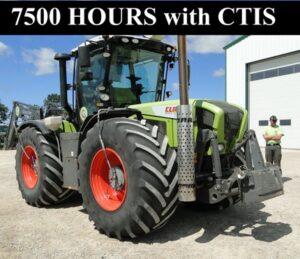
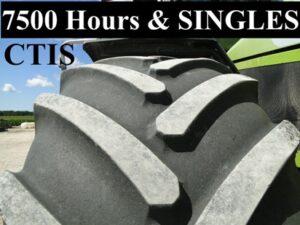
BKT USA, Inc.
Dave Paulk: Manager Field Technical Services
The life span of an Ag tire is dependent on how it is used and for what purposes. If an ag tire is used only in the field, they will last much longer before they wear out. Unfortunately, with farms scattered, and tractors traveling on the road, the life of ag tires is diminished because of the road wear.
On MFWD tractors, the fronts are drive tires, but wear out about 2-1 to the rears, especially where traveling on the road is required. The reason is that the fronts usually turn 1.3 to 1.5 times faster than the rears. The crown of the road also plays a part in how the tires wear. The right front tire will often wear out faster than the left front. The right rear will exhibit signs of road wear but are larger and don’t turn as many times as the fronts. The road wear doesn’t show up as quickly. Rotating the fronts from right to left will prolong the life for a while longer.
Proper air pressures for the application, weight, and speed are important to taking care of your tires. Underinflated and overloaded tires will fail prematurely and cost money to replace. Air pressures used for field work versus air pressures needed for transporting on the road are different. The faster that equipment runs, the less load carrying capacity a tire has. When ran underinflated at highway speeds, heat generated by the tire is not dissipated as quickly and can cause tire failure (ply gap separations, sidewall separations, and bead damage).
Using the correct recommended wheels is important in several ways. Generally, there is a recommended wheel with alternates. The recommended wheel will give the tire a better footprint on the soil and on the road. Where compaction is important, the tire is spread out over a larger area (longer and wider). Recommended alternate wheels will work without damaging the tire, but sometimes don’t give the optimum footprint. If wheels are too narrow, it pulls the sidewalls of the tires in and puts more pressure in the middle of the tire tread. If wheels are too wide, the beads are pushed out and creates undue pressure in the bead area and lower sidewall. VF tires play prominently into this as they can be run at lower air pressures and give a wider and longer footprint with the correct wheels.
A problem that plagues farm tires is stubble damage. GMO plants are much stronger and harder than what was planted before. Cotton, soybeans, corn, and sunflowers are a few of the GMO plants in use today. The stalks are much harder than rubber and can go straight through an ag tire when driven on or across the stalks. There are several ways to combat stubble damage issues. Stalks can be cut a little taller and not right at the ground. This allows the front tires on the combine and the tractor to push them over instead of sticking into the tire. Stubble guards or stubble stompers can be used to push the stalks over before running over them with the tire. Instead of running directly over the stalks with the tractor tires, straddle the rows, if possible, to avoid damage to the tires. Although some manufacturers have stubble damage warranties, a farmer still must pay for the labor and most warranties for stubble damage are not free replacements. It can be quite expensive to replace tires for this reason when it is unnecessary.
Compounding of the rubber for the tread is important for stubble damage and compounding for tread and sidewalls for ozone protection. Ozone is a killer for rubber products. Most tires have some type of ozone protection built in, and must have this protection to have a normal life span. Without ozone, if a tire is used only a few weeks a year and sits out in the sun, it will start cracking in a few years.
The use of steel belts in ag tires can serve a dual purpose. Tires can be made with a steel belt in the tread area or made with an all-steel casing. A steel belt strengthens the casing and offers a measure of resistance to punctures in the tread area. It doesn’t make tires bullet proof, but the steel belt does help. They also help the integrity and form of the casing stay intact. Some tires are made with all steel casings. These tires have steel running from bead to bead in a radial design. This helps to minimize damage to the sidewalls and tread area of the tire.
Tires should be taken care of when stored in the winter or downtime to save time and money. Before storing for a long period of time, such as over the winter, there are several things that can be done to minimize problems in the spring. Air the tires up to near maximum air pressure before storing. Because of ambient air temperatures, air pressures will go up and down. If they happen to go flat, the rim can cut into and damage the tire. Store out of the sunlight if possible. The ozone in the air can damage the tires and cause them to crack prematurely. Store tires away from fossil fuel-based liquids. These are harmful to rubber products and can cause the rubber to deteriorate over time. It is also wise to clean the dirt, mud, sticks and rocks from the wheels. A little bit of prevention saves money down the road.
All information is provided in this blog solely to provoke thought. All deductions made from information on this site must be confirmed by Certified Ag Tire Dealer & Tire Manufacturer before use. Ag Tire Talk does not recommend anyone conduct tire service work with exception of Certified Ag Tire Dealer Professionals.

